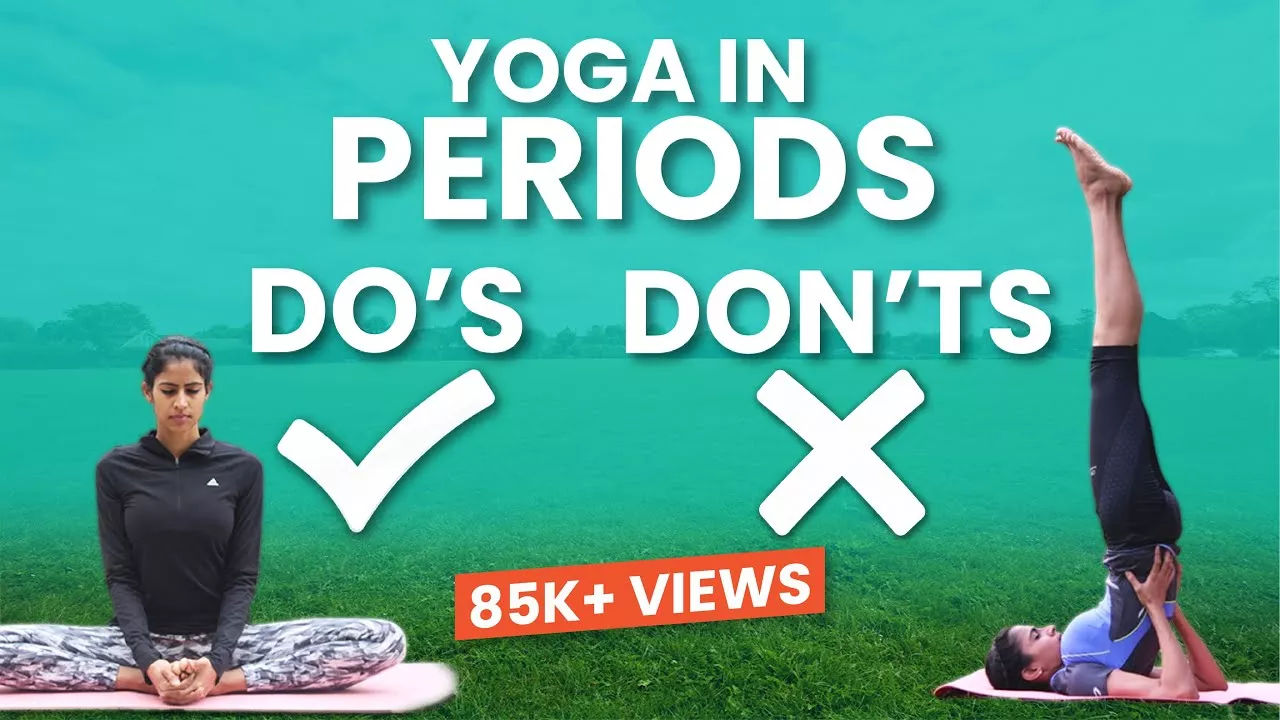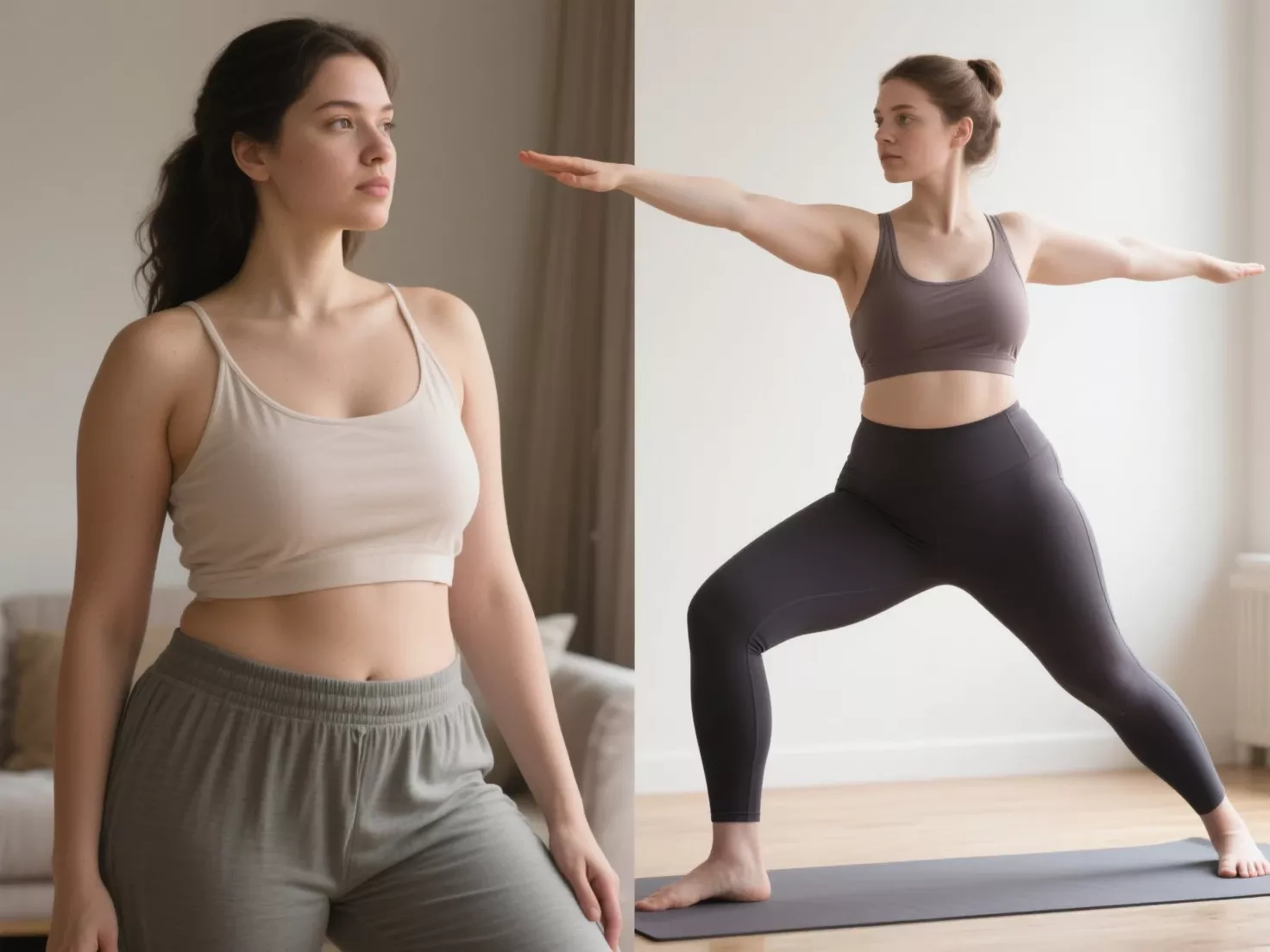Yes, yoga can be practiced during menstruation and may even help alleviate some of the discomforts associated with your period.
However, it’s important to adjust your practice to align with your body’s needs during this time.

Understanding the benefits, recommended poses, and practices to avoid can make your yoga sessions during menstruation both safe and effective.
Benefits of Yoga During Periods
1. Relief from Menstrual Cramps:
- Gentle yoga poses help relax the muscles of the lower abdomen, reducing cramps and tension.
- Stretching and breathing techniques increase blood flow, which can soothe pain and reduce inflammation.
2. Improved Mood:
- Yoga stimulates the release of endorphins, the body’s natural feel-good chemicals, which can help combat mood swings and irritability caused by hormonal changes.
- Mindful breathing promotes relaxation, reducing stress and anxiety that may arise during menstruation.
3. Alleviation of Bloating and Fatigue:
- Poses that gently compress and stretch the abdominal region aid digestion and reduce bloating.
- Restorative poses provide relaxation, helping to counteract the fatigue that often accompanies periods.
4. Regulated Blood Flow:
- Certain yoga poses promote better circulation, ensuring a healthy flow during menstruation and reducing stagnation that may contribute to discomfort.
Recommended Yoga Poses During Periods
Practicing the right yoga poses during menstruation can help alleviate common period-related discomforts like cramps, bloating, and fatigue.
These poses focus on relaxation, gentle stretching, and improving circulation, making your practice safe and effective.
Below are detailed instructions for each recommended pose:
1. Child’s Pose (Balasana)
A deeply restorative pose, Child’s Pose helps relieve tension in the lower back and hips while promoting relaxation.

How to Do It:
- Kneel on the mat with your knees wide apart, toes touching.
- Sit back on your heels and extend your arms forward, lowering your torso onto your thighs.
- Rest your forehead on the mat or a cushion for support.
- Hold the pose for 1–2 minutes, breathing deeply and feeling your lower back and hips release tension.
Benefits:
- Gently stretches the spine, hips, and thighs.
- Relieves lower back pain and abdominal discomfort.
- Calms the mind and reduces stress.
2. Cat-Cow Pose (Marjaryasana-Bitilasana)
This flowing sequence helps improve spinal flexibility and eases tension in the lower back, which is common during periods.

How to Do It:
- Start on all fours with your wrists under your shoulders and knees under your hips.
- Inhale and arch your back, lifting your chest and tailbone toward the ceiling (Cow Pose).
- Exhale and round your spine, tucking your chin to your chest and drawing your belly toward your spine (Cat Pose).
- Continue this flow for 1–2 minutes, syncing your movements with your breath.
Benefits:
- Improves blood circulation in the pelvic region.
- Relieves tension in the spine and abdominal area.
- Promotes relaxation and relieves bloating.
3. Bound Angle Pose (Baddha Konasana)
This hip-opening pose provides relief from menstrual cramps and improves flexibility in the pelvic area.

How to Do It:
- Sit on the mat with your legs extended.
- Bend your knees and bring the soles of your feet together, allowing your knees to drop outward.
- Hold your feet with your hands and sit tall, lengthening your spine.
- For a deeper stretch, gently press your elbows on your knees or lean slightly forward.
- Hold for 1–2 minutes, breathing deeply.
Benefits:
- Stretches the inner thighs and hips.
- Improves circulation to the pelvic region.
- Alleviates tension in the lower body.
4. Supine Twist (Supta Matsyendrasana)
A gentle twisting pose that massages the abdominal organs and soothes the lower back.

How to Do It:
- Lie on your back with your legs extended.
- Draw your right knee toward your chest and extend your right arm out to the side.
- Gently guide your right knee across your body with your left hand, letting it rest on the floor or a cushion.
- Turn your head to the right and breathe deeply for 1–2 minutes.
- Switch sides and repeat.
Benefits:
- Relieves bloating and abdominal discomfort.
- Stretches the lower back and hips.
- Promotes relaxation and improves digestion.
5. Legs-Up-The-Wall Pose (Viparita Karani)
A calming and restorative pose that reduces fatigue and swelling in the legs while promoting relaxation.

How to Do It:
- Sit sideways next to a wall, then lie back and swing your legs up against the wall.
- Adjust your position so your hips are close to the wall, and your legs are comfortably extended upward.
- Rest your arms by your sides or place your hands on your belly.
- Hold for 5–10 minutes, focusing on slow, deep breaths.
Benefits:
- Eases lower back pain and leg swelling.
- Improves circulation and reduces fatigue.
- Promotes relaxation and mental clarity.
6. Corpse Pose (Savasana)
The ultimate relaxation pose, Savasana allows your body and mind to fully rest and rejuvenate.

How to Do It:
- Lie flat on your back with your legs extended and arms resting slightly away from your body, palms facing up.
- Close your eyes and take slow, deep breaths, allowing your body to fully relax.
- Focus on releasing tension from each part of your body, starting from your head and moving downward.
- Stay in this pose for 5–10 minutes.
Benefits:
- Calms the nervous system and promotes deep relaxation.
- Eases physical and mental tension.
- Allows the body to recharge and restore energy.
Yoga Practices to Avoid During Periods
While yoga can be a wonderful way to alleviate menstrual discomfort, some poses and practices may put unnecessary strain on your body during menstruation.
To ensure a safe and beneficial practice, it’s essential to avoid certain movements that might disrupt your body’s natural processes or increase discomfort.

Below is a detailed guide to yoga practices to steer clear of during your period and why:
1. Inversions (Headstands, Shoulder Stands, etc.)
Why Avoid Them:
Inversions, where the head is below the heart, reverse the natural flow of blood. Some yoga traditions believe this disrupts the natural energy of menstruation and may create hormonal imbalances.
Physically, these poses can increase pressure on the uterus, potentially worsening cramps or other discomforts.
Examples of Poses to Skip:
- Headstand (Sirsasana)
- Shoulder Stand (Sarvangasana)
- Plow Pose (Halasana)
- Handstand (Adho Mukha Vrksasana)
Alternative Practice:
Instead of inversions, try restorative poses like Legs-Up-The-Wall (Viparita Karani), which provides similar relaxation benefits without reversing blood flow.
2. Intense Core Work
Why Avoid Them:
Poses that heavily engage the abdominal muscles can exacerbate cramps and create additional pressure in the pelvic region.
During menstruation, the abdominal area is often more sensitive, making these poses uncomfortable or even painful.
Examples of Poses to Skip:
- Boat Pose (Navasana)
- Plank Pose (Phalakasana)
- Side Plank (Vasisthasana)
- Any variations of sit-ups or crunches within a yoga sequence
Alternative Practice:
Focus on gentle poses that provide a mild stretch to the abdominal area, like Bound Angle Pose (Baddha Konasana) or Cat-Cow (Marjaryasana-Bitilasana).
3. High-Intensity or Dynamic Yoga Styles
Why Avoid Them:
Vigorous practices such as Power Yoga or Ashtanga Yoga require significant energy and may leave you feeling drained, as your body is already expending energy during menstruation.
These styles often include sequences that strain the abdominal area and increase heat in the body, which can worsen bloating or fatigue.
Examples of Styles to Pause:
- Power Yoga
- Ashtanga Yoga
- Bikram Yoga (Hot Yoga)
Alternative Practice:
Opt for slower-paced styles like Hatha Yoga, Yin Yoga, or Restorative Yoga, which emphasize relaxation and gentle stretching.
4. Deep Twisting Poses
Why Avoid Them:
Twisting poses compress the abdominal and pelvic region, which may interfere with the natural flow of menstruation.
This can worsen cramps, increase tension, and lead to discomfort in the lower back or abdomen.
Examples of Poses to Skip:
- Revolved Triangle Pose (Parivrtta Trikonasana)
- Revolved Side Angle Pose (Parivrtta Parsvakonasana)
- Seated Twist Pose (Ardha Matsyendrasana)
Alternative Practice:
Substitute deep twists with gentler variations like Supine Twist (Supta Matsyendrasana), where the body is supported and the twist is less intense.
5. Backbends and Heart-Opening Poses
Why Avoid Them:
Deep backbends stretch the abdominal muscles and may pull on the ligaments around the uterus, intensifying cramps.
Heart-opening poses can also create excessive strain on the lower back, which may already be sensitive during menstruation.
Examples of Poses to Skip:
- Wheel Pose (Urdhva Dhanurasana)
- Camel Pose (Ustrasana)
- Bow Pose (Dhanurasana)
- Cobra Pose (Bhujangasana) if done too intensely
Alternative Practice:
Try gentle, supported backbends using props, such as a bolster or cushion under the back in Reclining Bound Angle Pose (Supta Baddha Konasana) for a mild stretch and restorative effect.
6. Breath Retention (Kumbhaka) and Forceful Breathing (Kapalabhati)
Why Avoid Them:
Breathing techniques that involve holding the breath (Kumbhaka) or forceful exhalations (Kapalabhati) can strain the abdominal and pelvic area, leading to discomfort or dizziness.
These practices are also more taxing on the body, which may already feel fatigued during menstruation.
Examples of Practices to Skip:
- Kapalabhati (Skull-Shining Breath)
- Kumbhaka (Breath Retention)
- Bhastrika (Bellows Breath)
Alternative Practice:
Focus on calming and gentle breathing exercises, such as Diaphragmatic Breathing or Nadi Shodhana (Alternate Nostril Breathing), to promote relaxation and mental clarity.
Tips for a Comfortable Practice During Menstruation
1. Listen to Your Body:
- Your energy levels and symptoms may vary. If you feel tired or uncomfortable, prioritize rest over yoga.
2. Focus on Breathing:
- Incorporate deep, diaphragmatic breathing (pranayama) to calm your mind and reduce physical tension. Avoid breath retention or forceful breathing exercises like Kapalabhati during this time.
3. Practice Restorative Yoga:
- Opt for slow and gentle styles like Yin Yoga or Hatha Yoga, which focus on relaxation and stretching.
4. Use Props for Support:
- Bolsters, cushions, and blankets can make poses more comfortable, especially if you’re experiencing cramps or fatigue.
5. Stay Hydrated:
- Drinking water before and after your practice helps ease bloating and prevents dehydration.
Conclusion
Practicing yoga during periods can be a powerful tool for managing physical discomfort and emotional fluctuations.
The key is to listen to your body and adapt your practice with poses and techniques that prioritize comfort and relaxation.
By choosing gentle movements and focusing on mindfulness, yoga can enhance your overall well-being during menstruation.



